On the hunt for a hearing aid? Finding the right type and style for you depends on your degree of hearing loss, your lifestyle preferences, and cosmetic concerns.
As a starting point, there are two basic types of hearing aids:
- In-the-ear (ITE) hearing aids
- Behind-the-ear (BTE) hearing aids
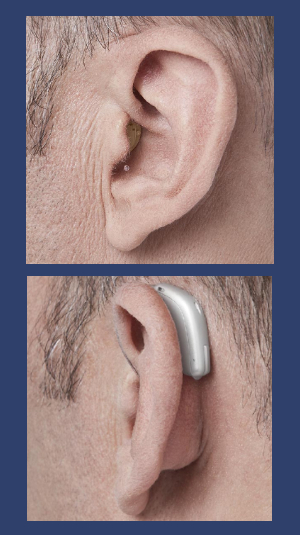
(All photos courtesy of Oticon.)
Table of Contents
In-the-ear (ITE) hearing aids
ITE aids are worn in the ear canal and are usually custom-fit, based on an impression that is taken by your hearing care professional at the time of your hearing aid consultation. These styles are typically available in different skin tones to blend with the outer ear. Some types of ITE hearing aids fit very deeply within the ear canal, while others are closer to the outer ear.
Behind-the-ear (BTE) hearing aids
BTE aids sit behind or on top of the outer ear with tubing that routes the sound down into the ear canal via a custom-fit earmold or a dome style that doesn’t block the entire ear canal opening. BTE styles are available in different colors to match hair or skin tone, as well as flashier designs for personalized flair.
For either ITE or BTE, most devices come with standard button batteries that must be replaced anywhere from 3-20 days. However, rechargeable batteries are becoming more common. Learn more about the pros and cons of rechargeable batteries.
Common hearing aid styles
In-the-ear styles
Invisible in the canal (IIC)
Completely in the canal (CIC)
_200x200.jpg)
(CIC) hearing aid is just barely
visible.
IIC and CIC styles are the smallest and most discreet hearing aids available. “Invisible in the canal” IIC styles are as described—virtually invisible. A wearer places them very deeply in the ears, and they must be removed by tugging on a small pull-out string. “Completely in the canal” CIC are very similar, but don’t sit quite so deeply within the ears.
These styles are typically fit for people with mild to moderate hearing loss. Because of their small size, they don’t usually come with any manual controls, like volume wheels or program buttons.
Advantages:
- very discreet
- good sound quality because of how they fit within the ear
Disadvantages:
- susceptible to ear wax and moisture damage
- small size can be a problem for dexterity
- small size also can be a problem for connectivity to wireless devices, like smartphones
In-the-canal (ITC) hearing aids
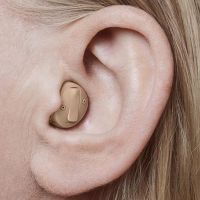
hearing aid.
ITC hearing aids sit in the lower portion of the outer ear bowl, making them comfortable and easy to use. Because they’re slightly larger than IIC and CIC styles, they tend to have a slightly longer battery life and can fit a wider range of hearing losses. Their size also allows them to host additional features such as directional microphones for better understanding in noisy environments and manual controls, like a volume wheel, if desired.
Advantages:
- discreet
- longer battery life and more features than IIC and CIC styles
Disadvantages:
- susceptible to ear wax and moisture damage
- more occlusion, can make wearers feel plugged up
- small size can be a problem for connectivity to wireless devices
Low-profile hearing aids
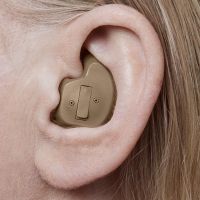
hearing aid.
Low-profile hearing aids are similar to ITC styles, and range from half-shell designs that fill half the bowl of the outer ear to full-shell designs that fill almost the entire outer ear bowl. Like ITC styles, low-profile designs are large enough to feature directional microphones and manual controls, such as a volume wheel and a push-button for changing programs. The size of a low-profile style makes it desirable for people with dexterity issues because it is easier to handle than the smaller sizes.
Advantages:
- larger size easier to insert and remove
- accommodates more features and user controls
- likely to have connectivity to wireless devices like phones
Disadvantages:
- less discreet than smaller in-the-ear styles
- more occlusion, can make wearers feel plugged up
Behind-the-ear styles
Receiver in the ear (RITE)
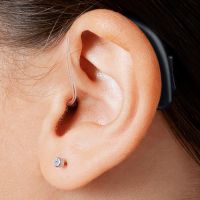
This style is typically known as either as “receiver in the ear” (RITE) or “receiver in canal” (RIC), depending on the manufacturer. But they essentially mean the same thing—an open-fit hearing aid style that has the speaker built into an insertable ear dome, instead of the main body of the hearing aid. In other words, the speaker of the hearing aid rests in the ear canal, but the microphone and processor sit in a tiny case behind the ear. They are connected by a thin wire. This style of hearing aid tends to have above-average sound quality and is made by all major hearing aid manufacturers.
If it gets damaged, the speaker portion of the hearing aid that fits in the ear can often be replaced at the hearing aid center, instead of having to be shipped off to the manufacturer for repair.
Advantages:
- generally the only style that comes with a rechargeable battery option
- most likely to come with wireless connectivity to devices like phones
- most likely to have advanced technology such as artificial intelligence
- the speaker can be replaced separately
- telecoil options are common
Disadvantages:
- smaller RITE sizes (known as mini-RITEs) can be a problem for dexterity
- speaker, which is inside the ear, is susceptible to moisture and ear wax damage
- the microphone and sound processor that sit behind the ear is visible
Behind-the-ear with earmold
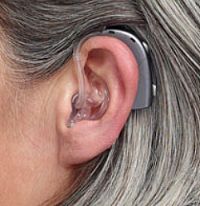
BTE styles that come with earmolds can fit any type of hearing loss, from mild to profound. Their longer shape follows the contour behind the outer ear and can generally house more features, controls and battery power than any other style of hearing aid. A BTE with earmold style is commonly used for children because the BTE can be reprogrammed as needed and the earmold can be replaced as the child grows.
Advantages:
- fits all degrees of hearing loss, including profound hearing loss
- usually available in models with wireless connectivity to devices and advanced technology
- custom-fit earmold can be replaced separately
- less susceptible to moisture damage
Disadvantages:
- more occlusion, can make wearers feel plugged up
- potential space limitations for eyeglass wearers
- not as cosmetically hidden
What is the best hearing aid for me?
Selecting and understanding what hearing aid is the right fit for you can be challenging. That’s why we created this flow chart to help first-time hearing aid users or individuals in the market for a new device figure out which hearing technology might be the best fit.
When it comes to hearing aids, there are multiple features and styles available to suit different hearing loss needs. It’s important to consider a number of different things when selecting the right style to fit your needs. (See legend below for acronyms).
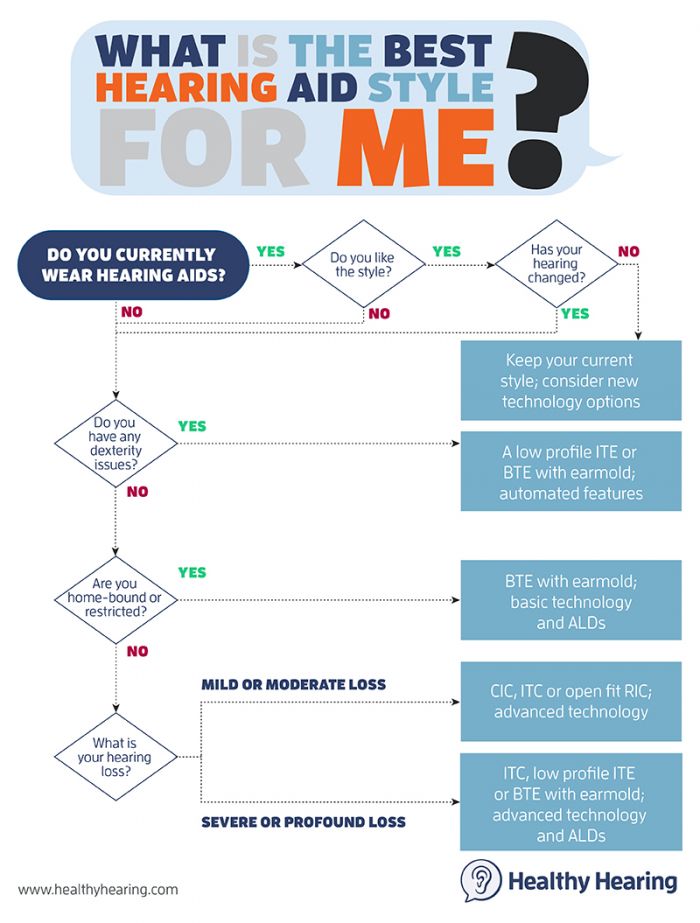
Flow chart legend: ALDs= assistive listening devices that can augment what hearing aids are capable of; advanced technology=generally the newest aids that cost more, but offer the most technologically advanced features; ITE=in the ear; BTE=behind the ear; CIC=completely in canal; ITC=in the canal; RIC=receiver in the canal (same as a RITE).
Do you currently wear hearing aids?
If you’re already wearing hearing aids and want to update them, the best place to start is with the current device style. If you’re happy with that style, you’ll often be able to find the same or a similar style to your outdated device, just equipped with newer and more modern features. It’s possible the type of hearing loss has changed over time, however, so it’s important to have your hearing tested before updating hearing aids. More: Signs you need a new hearing aid.
Do you have problems with dexterity?
If you have dexterity issues (for example, difficulty grasping small items or losing feeling in fingertips), it’s usually better to avoid smaller devices. Low-profile ITE or BTE devices with earmolds might be suitable because they are the largest instruments and easiest to handle. Additionally, the batteries will be the largest—size 13 or 675— which will allow for simpler battery swaps. Some BTE models come with rechargeable batteries, which are easy to use. Lastly, hearing aids that come with automated features should also be considered — so you don’t have to use the tiny buttons to adjust the volume. You may also want to talk to your hearing care practitioner about the possibility of a remote control if the volume or program controls on your hearing aids are difficult to use. More: All about hearing aid batteries.
Are your activities limited?
If you are homebound, restricted in daily activities or have cognitive impairments, BTE devices with earmolds might be most suitable. Selecting earmolds made of soft, flexible material can help it fit comfortably in the ear and make it easy for a caretaker to assist. Other items to consider include assistive listening devices, such as include amplified telephones, special smoke detectors, bed-shaker alarms, doorbells that flash a light or a device to amplify the television.
What is your hearing ability?
What kind of hearing loss do you have?
If you have hearing loss in both the low and high sounds (as in, you struggle to hear both squeaky and booming, bass-filled sounds), a more occluding fit from CIC or ITC styles will help process sound while still being quite discreet. The occlusion helps block out unwanted background noise.
But, if your hearing loss is primarily in the high frequencies—which most people have, especially if they have age-related hearing loss—the open-fit RITE styles are the most comfortable because they let in the natural low-frequency sounds you are still capable of hearing, while amplifying the high frequencies. These options can also be equipped with advanced features to allow hearing aids to filter noise from speech, adapt to different environments, suppress feedback and wirelessly connect to mobile phones, a personal microphone system or other public assistive listening devices.
Severe-to-profound loss: Power aids
If you have severe or profound hearing loss, ITC hearing aids, low-profile ITE hearing aids or BTE hearing aids with earmolds might be suitable, depending on the degree of loss. They are known as “power” or “super power” hearing aids. These styles of hearing aids provide the most powerful amplification and are least susceptible to moisture damage from the ear canal. Advanced features are important to consider, as they can filter noise from speech, adapt to different environments, suppress feedback and wirelessly connect mobile phones, a personal microphone system or other public assistive listening devices.
More: Hearing aids for profound hearing loss
Unilateral hearing loss
For people with single-sided deafness, options include a CROS or BiCROS hearing aid and a bone-anchored hearing system.
What about cochlear implants?
For some people, hearing aids won’t sufficiently address their hearing loss, and instead they may have better success with cochlear implants or a bone-anchored hearing system.
Do you need hearing aids?
Hearing aids can be fit for a broad range of hearing losses in more styles and sizes than ever before, in part due to the miniaturization of electronics. More people than ever can wear tiny, nearly invisible models, and even the larger-sized instruments are available in modern, sleek styles. Need to get fit for hearing aids, or think you have hearing loss? A good next step is visiting our directory of consumer-reviewed hearing healthcare professionals to find hearing aids near you.


